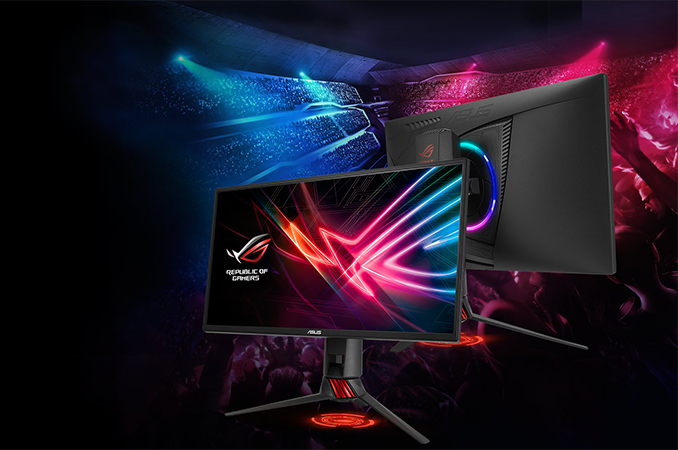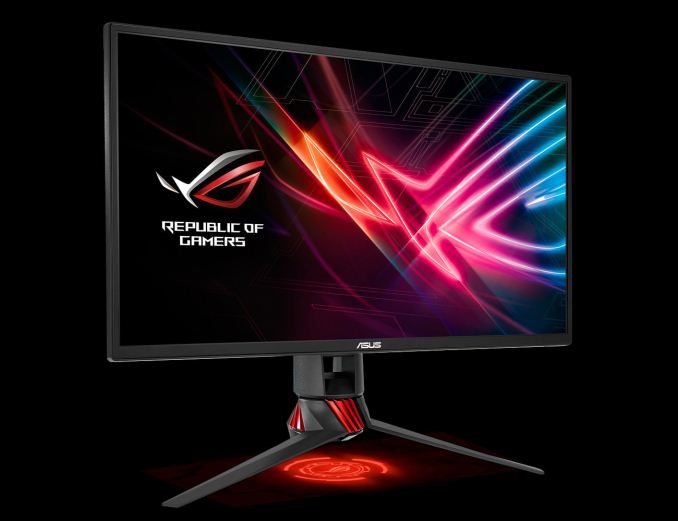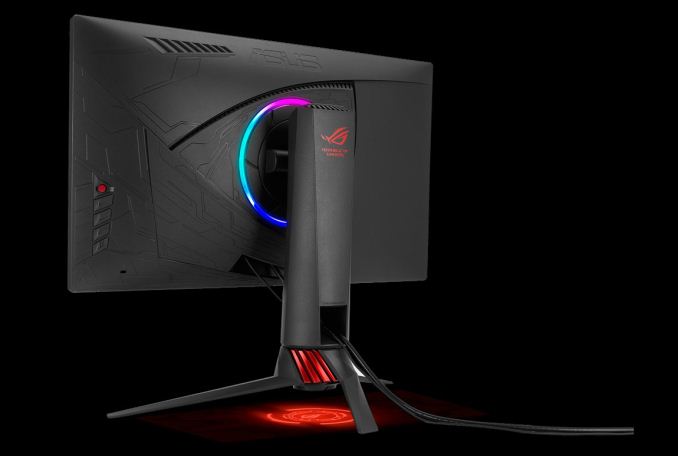ASUS Ships ROG Strix XG258Q ‘eSports’ LCD: 1080p 240 Hz Display w/FreeSync
by Anton Shilov on November 27, 2017 10:00 AM EST
ASUS has added a new ultra-fast monitor forhardcore gamers and eSports enthusiasts to its lineup. The new ROG Strix XG258Q resembles its close relative — the ROG Swift PG258Q — when it comes to key characteristics such as FHD resolution and 240 Hz refresh rate. However whereas the PG258Q is a G-Sync monitor, the new XG258Q uses AMD’s FreeSync instead. Along with the variable refresh features, the new monitor also features ELMB (extreme low motion blur) tech as well as ASUS’ Aura RGB lighting effects on the back.
The ASUS ROG Strix XG258Q is based on a 24.5” TN panel from AU Optronics with a FHD 1920×1080 resolution and a 16:9 aspect ratio. Since the display is aimed primarily at professional gamers, its main features are 1 ms GtG response time as well as a 240 Hz refresh rate. To make gameplay smoother, the XG258Q supports AMD’s FreeSync dynamic refresh technology that can work in the range between 48 and 240 Hz over either a DP 1.2 or HDMI 2.0 connection. Furthermore, ASUS equipped the monitor with its Extreme Low Motion Blur (ELMB) technology that promises to make fast-paced actions look sharper. ASUS first presented their ELMB/ULMB implementation several months ago, but still has not described how their variant of the tech works, and if it differs at all from typical ULMB backlight strobing.
The ither specifications of the ROG Strix XG258Q are typical for a fast modern TN-based monitor. The unit can display 16.7 million (6-bit + FRC) colors, has a typical contrast ratio for mainstream screens (1000:1), features 170°/160° viewing angles as well as offers a 400 cd/m2 brightness, which is bit higher compared to average monitors. As for connectivity, the new monitor can use HDMI 1.4 (but only for refresh rates up to 140 Hz), HDMI 2.0, or DisplayPort 1.2. As for ergonomics, the ROG Strix XG258Q can adjust height, tilt, swivel or can be attached to a VESA wall mounting.
Since we are dealing with an ROG monitor here, it is not surprising that the unit comes with a host of ASUS proprietary enhancements for gaming displays, including GamePlus OSD features, GameVisual modes that adjust for particular game genres and so on. In addition, to make the monitor look like all the latest gaming devices from ASUS and stand out from the other gaming LCDs, the XG258Q has the company’s customizable ROG signature projection on the bottom as well as the Aura RGB LEDs on the back.
| ASUS ROG 24" Displays with a 240 Hz Refresh Rate | |||
| ROG Strix XG258Q | ROG Swift PG258Q | ||
| Panel | 24.5" TN | ||
| Native Resolution | 1920 × 1080 | ||
| Refresh Rate | 240 Hz | ||
| Dynamic Refresh Rate | Technology | AMD FreeSync w/LFC | NVIDIA G-Sync |
| Range | 48 - 120 Hz for HDMI 1.4 48 - 240 Hz for HDMI 2.0, DP 1.2 |
30 - 240 Hz for DP 1.2 | |
| Response Time | 1 ms (gray-to-gray) | ||
| Brightness | 400 cd/m² | ||
| Contrast | 1000:1 | ||
| Viewing Angles | 170°/160° horizontal/vertical | ||
| Inputs | 1 × HDMI 1.4 1 × HDMI 2.0 1 × DisplayPort 1.2 |
1 × HDMI 1.4 1 × DisplayPort 1.2 |
|
| USB Hub | - | 2 × USB 3.0 | |
| Proprietary Enhancements | ELMB Trace Free Technology Color Temperature Selection: 4 Modes GamePlus Modes: Crosshair/Timer/Display Alignment Low Blue Light: Yes VividPixel: Yes GameVisual Modes: Scenery/Racing/Cinema/RTS/RPG/FPS/MOBA/sRGB |
ULMB Trace Free Technology Color Temperature Selection: 4 Modes GamePlus Modes: Crosshair/Timer/Display Alignment Low Blue Light: Yes GameVisual Modes: Scenery/Racing/Cinema/RTS/RPG/FPS/sRGB |
|
| Power Consumption |
Idle | ~0.5 W | |
| Active | 65 W at 200 cd/m² | ||
| Detailed Information | Link | Link | |
The ASUS ROG Strix XG258Q is already available for $449, which is over $50 cheaper than the current market price of the ROG Swift PG258Q featuring NVIDIA’s G-Sync.
Related Reading:
- BenQ Announces ZOWIE XL2546 ‘eSports’ Display: 24'', FHD, 240 Hz, DyAc ULMB Tech
- ASUS Launches ROG Swift PG27VQ: Curved 27-inch LCD with 165 Hz G-Sync & RGB Lighting
- ASUS ROG Strix XG27VQ Available: 27” Curved, FHD@144Hz & FreeSync w/ELMB
- ASUS Demonstrates ROG Swift PG27UQ: 4K, 144 Hz, HDR, DCI-P3 and G-Sync
- ASUS Adds Entry-Level VP28UQG to Gaming LCD Lineup: 28”, 4K, FreeSync, 1ms
- AOC Launches the AG352QCX: 35-Inch 200 Hz 2560×1080 Curved Display with Adaptive-Sync
Source: ASUS


















21 Comments
View All Comments
Morawka - Monday, November 27, 2017 - link
Wait for the new Asus Quantum Dot Monitors that got delayed. They have 200hz, IPS colors, with TN latency. It's the best of both worlds.Inteli - Monday, November 27, 2017 - link
For some people, those features aren't worth the cost, just like owning an RX-7 isn't worth the high cost of ownership and the inherent faults of a rotary.I would personally rather have a 144Hz IPS panel than 240Hz TN.
HiroshiTrinn - Monday, November 27, 2017 - link
What i'd give for a 30"+ (minimum) 2560x1600 ips quality screen with these refresh rates.Alistair - Monday, November 27, 2017 - link
None of those other features matter if it is a TN monitor. TN is really that bad!inighthawki - Monday, November 27, 2017 - link
Sounds like you've never used a quality TN panel. At extreme viewing angles there is still noticeable color quality differences, but my TN gaming panel has near identical image quality to my dell ultrasharp IPS panel sitting right next to it. I think the only people who would notice a difference are professionals and those who are trying to be pretentious.Ninhalem - Monday, November 27, 2017 - link
Yeah TN .... nope. I value my eyeballs and not making my vision worse.LordanSS - Monday, November 27, 2017 - link
Reading all the comments above, complaining about the TN panel and whatnot...It's safe to assume that this product is not targeted at the majority of the readers of this website, myself included, but eSports players instead (or players who want to make use of the product's benefits).
I will not deny that an IPS or even a VA panel has much better color accuracy over a TN. But IPS/VA even overclocked to 120Hz+ have an issue that is not present on TN: motion blur due to slower pixel shift.
There are several videos out there reviewing high refresh rate panels using IPS/VA panels for gaming, and most of them point out its shortcomings. For a high-end player making money out of playing those games, that's not acceptable. Those guys are, most of the time, stuck to TN.
firerod1 - Monday, November 27, 2017 - link
My IPS ultrawide has 1ms ULMB mode!inighthawki - Tuesday, November 28, 2017 - link
Time to break out the good old CRT :)Morawka - Monday, November 27, 2017 - link
More Gsync, Less Freesync Asus!